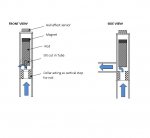"Yes, but a bit of thinking time up front will save hours of time later. I've got to get a good, practical solution in my head before I'll even bother giving it a go. "
- I agree 100%
"but can't tell that one until put into practice"
- Sometimes what looks nice when circulating in the 'grey matter' doesn't work very well in the Real World where you will have unknown fluid speed, pressure etc. What happens when a tap is turned on/off on the outflow? Not to mention laminar and turbulent thingies.
Hence my suggestion to prototype.
Trouble is that when it gets to engineering then it can be pricey and/or fiddly and a cheap bodge may be awful but the same thing made properly works beautifully.
"recommended travel for the magnet and a suitable cheap hall effect sensor"
- depends on sensor and magnet.
The temptation will be to buy the cheapest lump from Ebay, but maybe a few extra pennies could turn trash into genius...?
"anyone's thoughts on the inductor idea"
- I preferred that overall design, maybe in a tapered tube like the Big Boys do.
Its a bit like DPG's but elastic is replaced by gravity.
The Big Boys obviously spent more than 10 minutes on the problem and more than 10p on prototyping. Maybe substitute 'obviously' with 'hopefully'

As your inductance changes may be quite small I would lean towards either:-
1. Good old BFO design to maximise small changes. As used in cheap metal detectors.
2. An oscillator design, square it up and use PICAXE to count pulses.
Long term stability can be a problem with simple circuits.
Sorry haven't got any circuits to hand.

